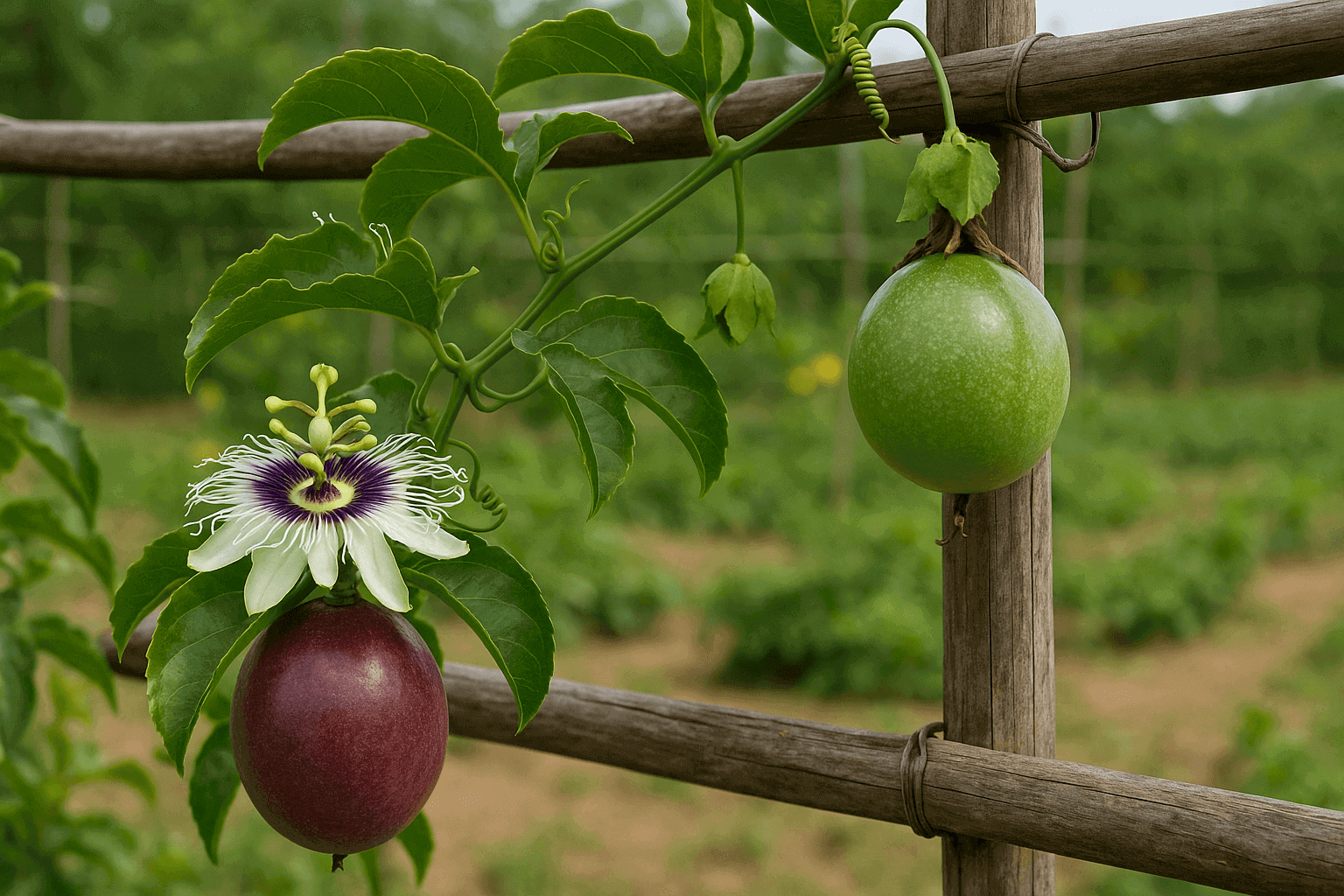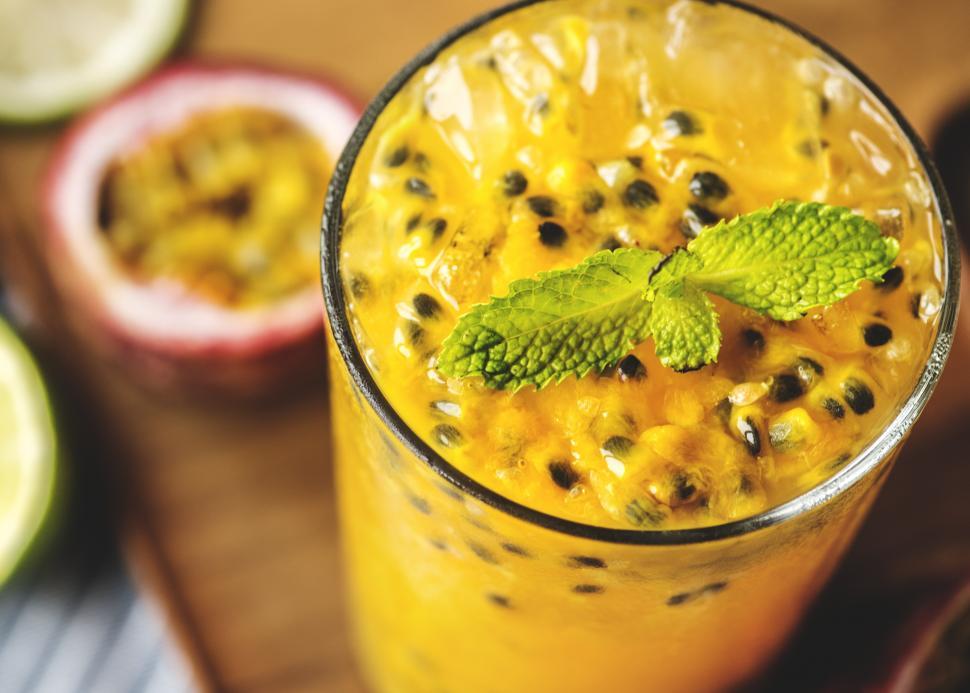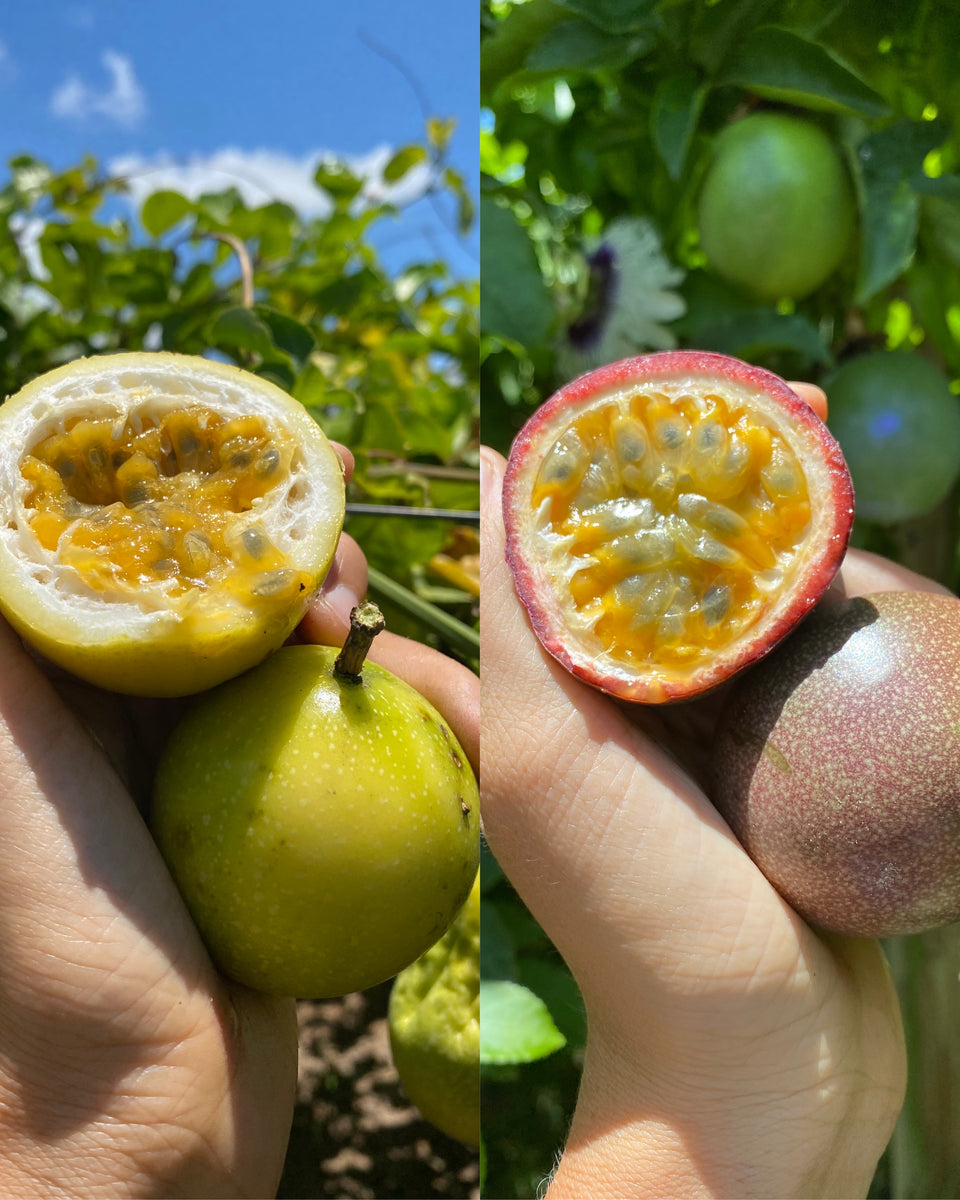
🌟 Passion Fruit at Home: The Complete Guide to This Exotic Superfruit
The most commonly asked question about passion fruit growing is: "Can I grow passion fruit in my own garden?" The answer is absolutely yes! Growing passion fruit at home is surprisingly rewarding when you plant them in sunny, well-drained soil with proper support structures, and with varieties like Purple Passion Fruit being self-fertile, you can enjoy homegrown exotic fruit even in smaller spaces. Whether you're a beginner gardener or an experienced green thumb, this tropical climber can thrive in your backyard with the right care, proper fertilizer, and suitable gardening tools.

🌍 The Fascinating Journey of Passion Fruit: From Tropics to Your Garden
Before we dive into the gardening details, let's appreciate the remarkable story of this exotic fruit. Originally native to South America, passion fruit (Passiflora edulis) has traveled across continents to become one of the most sought-after tropical fruits worldwide. The name "passion fruit" doesn't refer to romantic passion, but rather to the Passion of Christ – early missionaries saw Christian symbolism in the flower's intricate structure.
What makes passion fruit truly special for home gardeners isn't just its exotic appeal. This vigorous climbing vine can transform any garden space into a tropical paradise while producing incredibly nutritious fruit. The passion fruit flower is considered one of the most beautiful in the plant kingdom, with its complex structure featuring prominent stamens and pistils that create an almost otherworldly appearance.
Looking to expand your fruit garden knowledge? Understanding companion planting with flowering plants can significantly improve your passion fruit harvest!

(🌸 Looking to expand your fruit garden knowledge? Check out our comprehensive Types of Flowers Guide to learn about companion planting with flowering plants that can significantly improve your passion fruit harvest!)
🌡️ Understanding Passion Fruit Varieties: Purple vs. Yellow Types
Not all passion fruits are created equal, and choosing the right variety for your climate and space is crucial for success. There are two main types of passion fruit: Purple Passion Fruit (Passiflora edulis) and Yellow Passion Fruit (Passiflora edulis f. flavicarpa). This distinction is vital because selecting the wrong variety for your growing conditions is like trying to grow tropical plants in a cold climate – technically possible but practically challenging.
Purple passion fruit is generally more cold-tolerant and better suited for temperate climates. These are the reliable performers of the passion fruit world – they'll produce consistent harvests when given proper care and protection. The fruit has a deep purple skin when ripe and typically offers more intense, complex flavors that make them perfect for fresh eating.
Yellow passion fruit, on the other hand, prefers warmer, more tropical conditions but tends to be more productive and disease-resistant. These varieties are the workhorses of commercial passion fruit production, with larger fruits and higher juice content. For gardeners in warmer climates, yellow varieties often provide better yields and easier management.

🌱 Setting the Stage: Soil, Sun, and Space Requirements for Passion Fruit
Creating the perfect environment for your passion fruit vines starts with understanding their specific needs, which are more particular than many other fruit crops. Think of passion fruit vines as the performers of the fruit world – they need optimal conditions to deliver their best show.
Passion fruit thrives in well-drained, slightly acidic soil with a pH between 6.0 and 6.5, in full sun locations that receive at least 6-8 hours of direct sunlight daily. The emphasis on "well-drained" cannot be overstated – these tropical vines are extremely sensitive to waterlogged conditions. Poor drainage is the number one killer of passion fruit vines, leading to root rot and plant death faster than most other issues.
The soil should be rich in organic matter, which you can achieve by incorporating compost or well-aged manure before planting. This isn't just about nutrition – organic matter improves soil structure, water retention, and beneficial microbial activity. It's like creating a five-star hotel for your plant's root system.
Space planning is critical for passion fruit success. These vigorous climbers can easily reach 15-20 feet in length and need sturdy support structures. Unlike many fruit trees that grow upward, passion fruit vines spread horizontally and need substantial space to develop properly. Planning for this growth from the beginning prevents overcrowding and ensures adequate air circulation.
🌿 Planting Your Passion Fruit: Timing and Technique
Spring planting gives your passion fruit vines the entire growing season to establish before facing cooler weather. The timing should coincide with soil temperatures consistently staying above 60°F (15°C), which typically occurs 2-3 weeks after the last frost date in your area.
When planting, dig a hole twice as wide as the root ball but no deeper than the container. Passion fruit roots prefer to spread horizontally rather than growing deeply, so a wide, shallow planting hole encourages proper root development. The crown of the plant should sit at the same level it was growing in its nursery container – planting too deep can cause stem rot.
Spacing is crucial for healthy growth and disease prevention. Plant passion fruit vines 6-10 feet apart to ensure adequate air circulation and prevent overcrowding. Proper spacing also makes harvesting easier and reduces competition for nutrients and water. If you're growing multiple varieties, this spacing also helps prevent cross-pollination issues if you want to maintain variety characteristics.
After planting, water thoroughly and apply a 2-3 inch layer of organic mulch around the base, keeping it away from the stem. This mulch helps retain moisture, suppress weeds, and gradually improves soil quality as it decomposes.
(🌱 Curious about germination timelines for other plants? Our detailed guide on How Long Does It Take for Seeds to Sprout covers everything from vegetables to flowers and can help you plan your entire garden timeline!)
💧 Watering Wisdom: Mastering Passion Fruit Hydration
Passion fruit vines have specific water requirements that change throughout their growth cycle. Understanding these needs is essential for healthy growth and optimal fruit production. During the growing season, passion fruit needs consistent moisture but never waterlogged conditions.
Newly planted vines require regular watering for the first 6-8 weeks while their root systems establish. Water deeply but less frequently, encouraging roots to grow down rather than staying shallow. A good rule of thumb is to water when the top inch of soil feels dry to the touch.
Once established, passion fruit vines are somewhat drought-tolerant but produce better with consistent moisture. During fruit development, maintaining steady water supply becomes critical. Inconsistent watering during this period can cause fruit to drop prematurely or develop poorly.
The best watering method is drip irrigation or soaker hoses, which deliver water directly to the root zone without wetting the foliage. Wet leaves can invite fungal diseases, particularly in humid climates. Early morning watering allows any moisture on leaves to evaporate quickly, reducing disease risk.
🏗️ Support Systems: Building Strong Structures for Climbing Vines
Passion fruit vines are vigorous climbers that require substantial support structures. These aren't decorative garden plants that stay small and manageable – they're ambitious climbers with serious structural needs. A mature passion fruit vine loaded with fruit can weigh several hundred pounds, so your support system needs to be built accordingly.
The most effective support system is a strong trellis or pergola that can handle significant weight and wind stress. T-post systems work well for linear plantings, while pergola-style supports create beautiful overhead canopies perfect for outdoor living spaces. Whatever system you choose, ensure it's installed before planting – retrofitting support to established vines is extremely difficult.
Training young vines requires patience and regular attention. Guide the main stems along your support wires, securing them gently with soft ties. Don't be afraid to prune wayward shoots during the growing season – proper training creates a strong framework that supports heavy fruit loads.
The support structure should be at least 6-8 feet tall and extend horizontally for the full mature spread of your vines. Using galvanized hardware ensures longevity, as passion fruit vines can be productive for 15-20 years with proper care.

🌱 Fertilizing for Success: Feeding Your Productive Vines
Passion fruit vines are heavy feeders that require consistent nutrition throughout the growing season. Understanding their nutritional needs can dramatically impact both vine health and fruit production. These vigorous growers need balanced nutrition, with particular attention to potassium during fruit development.
Apply a balanced, slow-release fertilizer in early spring as new growth begins. A 10-10-10 or similar NPK ratio works well for most situations. Supplement with additional potassium during flowering and fruit set – potassium is crucial for flower development and fruit quality.
Organic gardeners can achieve excellent results with compost, aged manure, and organic fertilizers. Apply a 2-3 inch layer of compost around the base of vines each spring, keeping it away from the stem. This provides steady nutrition while improving soil structure and water retention.
Monthly applications of liquid fertilizer during the growing season help maintain consistent nutrition. Fish emulsion or seaweed extract work excellently for this purpose. Avoid high-nitrogen fertilizers late in the season, as they can promote soft growth that's more susceptible to pest and disease problems.
⏰ The Patience Game: Understanding Passion Fruit Production Cycles
Passion fruit vines typically begin producing their first meaningful harvest 12-18 months after planting, with full production starting in the second or third year. This timeline varies based on variety, growing conditions, and care quality, but patience is essential for success.
During the first year, focus on establishing a strong vine structure rather than expecting significant fruit production. Some flowers may appear, but it's often beneficial to remove early flowers to encourage vegetative growth and root development.
Once productive, passion fruit vines can produce fruit almost year-round in suitable climates, with peak production typically occurring during warmer months. A mature vine can produce 50-100 pounds of fruit annually, providing abundant harvests for fresh eating, juicing, and preservation.
The fruit is ready to harvest when it naturally falls from the vine or can be easily twisted off. Freshly harvested passion fruit will continue to ripen and develop flavor for several days after picking, reaching peak sweetness and aroma.
💪 Nutritional Powerhouse: Why Passion Fruit Deserves Garden Space
Understanding the nutritional value of passion fruit helps justify the space and effort required to grow it successfully. Passion fruit is exceptionally rich in vitamin C, dietary fiber, and antioxidants, making it one of the most nutritionally dense fruits you can grow.
One cup of passion fruit pulp contains approximately 230 calories, 5.2 grams of protein, and 24.5 grams of dietary fiber – that's nearly the entire daily fiber requirement for most adults. The fruit is also rich in vitamin A, potassium, and iron, creating a nutritional profile that supports overall health and wellness.
The high antioxidant content of passion fruit, including flavonoids and phenolic compounds, may help reduce inflammation and support immune system function. These compounds work synergistically to provide health benefits that extend beyond basic nutrition.
The seeds of passion fruit are also edible and add beneficial omega-6 fatty acids to the diet. Many people enjoy eating the entire fruit, seeds and all, for maximum nutritional benefit.
(🌰 Speaking of nutritious seeds and fruits, discover the amazing Health Benefits of Pistachios and how they complement a healthy garden-to-table lifestyle alongside your homegrown passion fruit!)
🍽️ Culinary Versatility: Using Your Passion Fruit Harvest
Fresh passion fruit offers incredible culinary versatility that extends far beyond simple snacking. The fruit's intense, tropical flavor makes it an excellent addition to both sweet and savory dishes, while its natural acidity provides balance in many recipes.
The most common use is for fresh juice, which can be enjoyed straight or mixed with other fruit juices. The pulp and seeds can be strained out for smooth juice, or left in for added texture and nutrition. Passion fruit juice is also excellent for cocktails, smoothies, and flavored waters.
For dessert applications, passion fruit pulp adds intense flavor to ice creams, sorbets, and baked goods. The natural acidity helps balance sweet desserts, while the tropical flavor creates sophisticated taste profiles that impress guests.
Savory applications include using passion fruit as a glaze for grilled meats, in salad dressings, or as a component in salsas and chutneys. The fruit's acidity makes it an excellent marinade ingredient for chicken and fish.
🔧 Troubleshooting Common Passion Fruit Challenges
Even with careful planning and attention, passion fruit growing can present challenges that require problem-solving skills. Understanding common issues and their solutions helps ensure long-term success with these rewarding vines.
Poor fruit set is often related to inadequate pollination or environmental stress. Passion fruit flowers are complex and sometimes require hand pollination for optimal fruit set. Using a small brush to transfer pollen between flowers can dramatically improve fruit production.
Leaf yellowing can indicate several issues, from overwatering to nutrient deficiencies. Start by checking soil drainage and moisture levels before adjusting fertilization. Often, improving drainage solves yellowing problems more effectively than adding nutrients.
Pest management focuses primarily on aphids, scale insects, and fruit flies. Regular inspection allows early detection and treatment before problems become severe. Beneficial insects like ladybugs and lacewings provide natural pest control when encouraged with diverse plantings.
Fungal diseases can be problematic in humid conditions or with poor air circulation. Ensuring adequate spacing, proper pruning, and avoiding overhead watering helps prevent most fungal issues.
🌟 Looking Forward: Your Passion Fruit Growing Journey
Growing passion fruit successfully requires dedication, patience, and attention to detail, but the rewards extend far beyond the harvest. There's immense satisfaction in nurturing these exotic vines from small plants to productive, mature specimens that provide tropical fruit for years to come.
The journey teaches valuable lessons about long-term garden planning and the importance of proper infrastructure. Each season brings new growth, new challenges, and new opportunities to refine your growing techniques and expand your knowledge.
As your vines mature and begin producing substantial harvests, you'll join a relatively exclusive group of home gardeners growing truly exotic fruit. Passion fruit remains uncommon in most temperate gardens, making your success all the more rewarding and impressive to fellow gardeners.
The investment in time, effort, and proper gardening tools required to establish productive passion fruit vines pays dividends for many years. With proper care, these vines can continue producing quality fruit for 15-20 years, making them one of the most rewarding long-term garden investments possible.
(🥝 Ready to expand your exotic fruit collection? Learn How to Grow Kiwi Fruit at Home - another superfruit that pairs perfectly with passion fruit in both the garden and kitchen!)
🌿 Ready to start your passion fruit growing adventure? Share your progress and connect with fellow gardeners by following us on Instagram @gradina.space!
